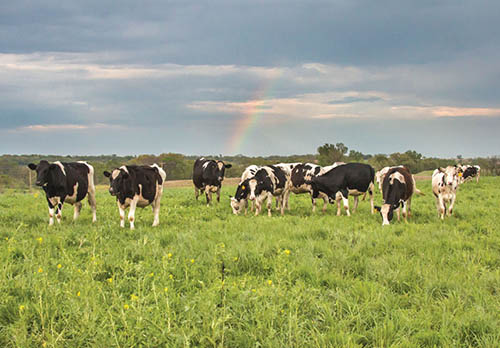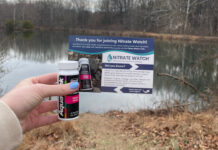
By Chase Castle
[email protected]
Dairy operations can be capital intensive, requiring significant investments in land, equipment and infrastructure.
“There’s never enough money for what needs to happen,” Farmers Creamery Supply Chain Director Phil Forbes said.
That’s why the dairy producer located in Wellman reached out to consumers this spring to help address a shortfall in the availability of organic milk – an essential part of the company’s product line, which includes butter, yogurt and cheese carried by grocers throughout the country.
The initiative began after the company appealed to Amish and Mennonite dairy farmers in Kalona and proposed moving their cattle not yet mature enough for milk production to the roughly 600 acres of organic pastures at Marilyn Farms, where Mr. Forbes serves as president. With more space on their own land for milk-producing dairy cows, farmers in Kalona could increase their organic milk output during the growing season.
To meet USDA organic regulations, however, the pastures at Marilyn Farms will initially require about $20,000 worth of additional fencing. Over the course of a month, organizers successfully met that goal through Kickstarter, a fundraising website that allows organizations to conduct short crowdfunded campaigns.
“It’s a unique way to approach the problem,” Mr. Forbes said. “We’re trying to raise money for fencing, but we were also trying to engage the customer in it, and we’ve really been successful on both ends.”
Mr. Forbes said the idea of seeking funding from the public to address the shortfall in the supply chain was first planted two years ago, when Farmers Creamery CEO Bill Evans attended a business event in the Corridor that featured a presentation on crowdfunding.
“He was floored that you could do a project and people could do their part,” Mr. Forbes said.
Along with marketing director Mindy Seiffert and manager Sara Rissi, Farmers Creamery representatives embarked on what they described as a fast-paced fundraising push. In addition to targeting different donors and amping up external communications, the Kickstarter model requires all campaigns to meet their goals within a chosen timeframe – in the case of Farmers Creamery, 30 days – otherwise no funding is collected.
Ms. Seiffert said that timeframe prompted more administrative strain than originally expected, and said smaller companies with similar goals may want to consider outsourcing some of their marketing efforts.
“There was tremendous amount of activity in a short amount of time,” she said. “For a lot of entrepreneurs, if you don’t have a big company, that’s intense to just focus for 30 days on Kickstarter.”
Despite those challenges, the project succeeded, in part because of good timing, Mr. Forbes said. The USDA reported that the total sales for organic milk products grew 4 percent in 2012 and 5 percent in 2013. As the 12th largest milk-producing state in the U.S., overall milk sales in Iowa generated approximately $944 million last year.
“It’s a perfect storm, because organic dairy is on a strong trajectory right now, and there’s not enough in the United States,” he said.
The organic push
In 1990, when Mr. Forbes joined Marilyn Farms, he said U.S. agricultural communities were just starting to become conscientious about environmental and health concerns related to crop production and pesticide use. That eventually inspired Marilyn Farm’s founders, Gary and Marilyn Hargrave, to experiment with grass-fed cows.
“They were trying to figure out how to use another model, and just the idea of something that was going to be raised on grass really resonated with them,” Mr. Forbes said.
Following traditional farming models used in comparable climates such as Ireland and New Zealand, he said, the couple soon realized business advantages of their new model. Livestock grazing on pastures circumvented unpredictable price variations on feed such as corn and soybeans, he said. The grazing process also increases the fertility of pastures’ top soil, he said.
“All those things are very beneficial to a 100 percent grass-fed operation,” he said.
The advantages of organic dairy appear to extend to the consumer end as well. A 2013 study published by the National Institutes of Health stated that the intakes of omega-6 fatty acids in Western diets have dramatically increased over the last century, while omega-3 intakes have fallen, creating an off-balance ratio that contributes to a wide range of health problems. Organic milk, meanwhile, typically has about 25 percent less omega-6 acids and 62 percent more omega-3, coming closer to the optimal 2.3 ratio than conventional milk.
“So all those play into a consumer side that people will pay a premium price for,” Mr. Forbes said.
The benefits of premium market prices haven’t been lost on local cow farmers either, he said. The demand for access to organic pastures is extremely high, with many farmers confiding that they’ve been paid to remove cows from land in order to free space for milk-producing heifers, Mr. Forbes said.
“A pasture is a gold mine,” he said. “Anything that you can do to get more cows on your pasture is money to you.”
Mark Rasmussen, director of the Leopold Center for Sustainable Agriculture at Iowa State University, reiterated that demand is increasing nationally for organic dairy, but added that organic farming’s restrictive feed diets create a supply-demand inequality that requires creative solutions among producers.
“I’m always impressed with people finding alternatives and workarounds to a problem they’re facing in farming,” he said.




